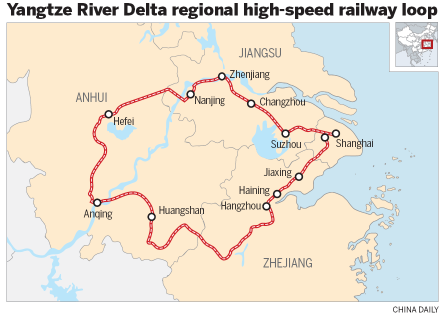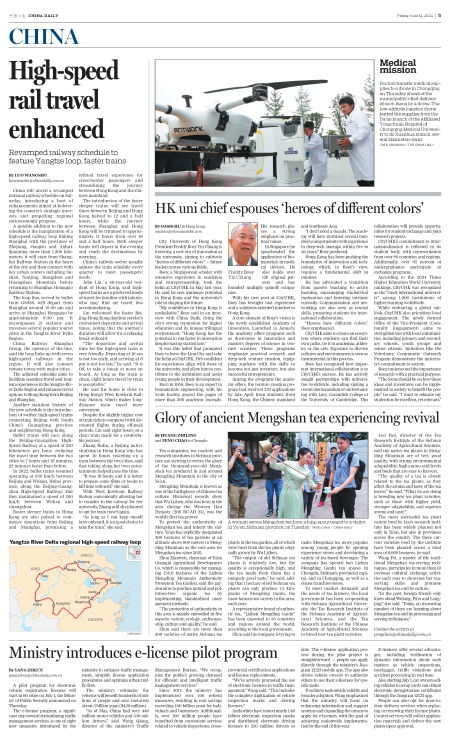
Yangtze River Delta regional high-speed railway loop
China will unveil a revamped national railway schedule on Saturday, introducing a host of enhancements aimed at bolstering the country's strategic interests and propelling regional socioeconomic progress.
A notable addition to the new schedule is the inauguration of a high-speed railway loop linking Shanghai with the provinces of Zhejiang, Jiangsu and Anhui. Spanning more than 1,200 kilometers, it will start from Shanghai Railway Station in the heart of the city and then connect with key urban centers including Suzhou, Nanjing, Hangzhou and Huangshan Mountain before returning to Shanghai Hongqiao Railway Station.
The loop line, served by bullet train G8388, will depart from Shanghai around 10:30 am and arrive at Shanghai Hongqiao by approximately 6:30 pm. It encompasses 21 stations and traverses several popular tourist cities in the Yangtze River Delta Region.
China Railway Shanghai Group, the operator of the line, said the loop links up with seven high-speed railways in the region. It will also connect remote towns with major cities.
The adjusted schedule aims to facilitate seamless travel and tourism experiences in the Yangtze River Delta Region and enhance travel options to Hong Kong from Beijing and Shanghai.
Another standout feature of the new schedule is the introduction of swifter high-speed trains connecting Beijing with South China's Guangdong province and neighboring Hong Kong.
Bullet trains will race along the Beijing-Guangzhou High-Speed Railway at a speed of 350 kilometers per hour, reducing the travel time between the two cities to 7 hours and 16 minutes, 22 minutes faster than before.
In 2022, bullet trains resumed operating at 350 km/h between Beijing and Wuhan, Hubei province, along the Beijing-Guangzhou High-Speed Railway. But they maintained a speed of 300 km/h between Wuhan and Guangzhou.
Faster sleeper trains to Hong Kong are also poised to commence operations from Beijing and Shanghai, promising a refined travel experience for cross-border passengers and streamlining the journey between Hong Kong and the Chinese mainland.
The introduction of the faster sleeper trains will see travel times between Beijing and Hong Kong halved to 12 and a half hours, while the journey between Shanghai and Hong Kong will be trimmed to approximately 11 hours from over 19 and a half hours. Both sleeper trains will depart in the evening and reach the destinations by morning.
China's railway sector usually adjusts the train schedule every quarter to meet passengers' needs.
John Lin, a 40-year-old resident of Hong Kong, said high-speed trains are a preferred mode of travel for families with infants, who may find air travel less accommodating.
Lin welcomed the faster Beijing-Hong Kong daytime service's convenient departure and arrival times, noting that the journey's duration will allow for a relaxing break onboard.
"The departure and arrival time for the high-speed train is very friendly. Departing at 10 am is not too early, and arriving at 6 pm is not too late," he said. "It is OK to take a break at noon on board. As long as the train is clean, eight hours travel by train is acceptable."
He said his home is close to Hong Kong's West Kowloon Railway Station, which makes long-distance train travel more convenient.
Despite the slightly higher cost of train tickets compared with discounted flights during off-peak periods, Lin said eight hours on a clean train made for a comfortable journey.
Zhang Rulin, a Beijing native studying in Hong Kong who has spent 10 hours traveling on a train between the two cities, said that taking along her own entertainment helped pass the time.
"It was 10 hours, and it is better to prepare some films or books to kill time onboard," she said.
With West Kowloon Railway Station conveniently allowing her to transfer to the subway for her university, Zhang said she planned to opt for train travel again.
"As long as I can keep myself busy onboard, it is a good choice to take the train," she said.
luowangshu@chinadaily.com.cn

